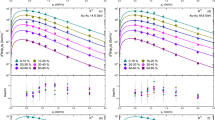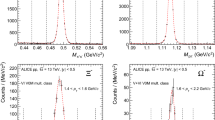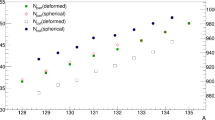Abstract
In this paper, we propose an observable counting a weighted difference between right-handed and left-handed lepton pairs, which is coined dilepton helical rate. The weight is the momentum difference of the lepton pairs projected onto an auxiliary vector. We derive the helical rate in a quark-gluon plasma with a vorticity in the limit when the quark and lepton masses are ignored. We find the helical rate is maximized when the auxiliary vector is parallel to the vorticity, in which case it has a nearly spherical oblate ellipsoidal distribution. We propose that it can be used as a vortical-meter for quark-gluon plasma.



Similar content being viewed by others
Data Availability Statement
This manuscript has no associated data or the data will not be deposited. [Authors’ comment: Data sharing is not applicable to this paper because no datasets were generated or analyzed in the current study.]
Notes
By right-handed lepton pairs, we refe r to right-handed fermion and left-handed anti-fermion. Similar terminology applies to left-handed spinors.
Here we use helicity of spinor, i.e. both right-handed electron and left-handed positron carry helicity one half.
References
W.T. Deng, X.G. Huang, Phys. Rev. C 93(6), 064907 (2016). https://doi.org/10.1103/PhysRevC.93.064907. arXiv:1603.06117 [nucl-th]
Y. Jiang, Z.W. Lin, J. Liao, Phys. Rev. C 94(4), 044910 (2016) [erratum: Phys. Rev. C 95(4), 049904 (2017)]. https://doi.org/10.1103/PhysRevC.94.044910. arXiv:1602.06580 [hep-ph]
Z.T. Liang, X.N. Wang, Phys. Rev. Lett. 94, 102301 (2005) [erratum: Phys. Rev. Lett. 96, 039901 (2006)]. https://doi.org/10.1103/PhysRevLett.94.102301. arXiv:nucl-th/0410079 [nucl-th]
Z.T. Liang, X.N. Wang, Phys. Lett. B 629, 20–26 (2005). https://doi.org/10.1016/j.physletb.2005.09.060. arXiv:nucl-th/0411101 [nucl-th]
F. Becattini, F. Piccinini, J. Rizzo, Phys. Rev. C 77, 024906 (2008). https://doi.org/10.1103/PhysRevC.77.024906. arXiv:0711.1253 [nucl-th]
B. Betz, M. Gyulassy, G. Torrieri, Phys. Rev. C 76, 044901 (2007). https://doi.org/10.1103/PhysRevC.76.044901. arXiv:0708.0035 [nucl-th]
J.H. Gao, S.W. Chen, Wt. Deng, Z.T. Liang, Q. Wang, X.N. Wang, Phys. Rev. C 77, 044902 (2008). https://doi.org/10.1103/PhysRevC.77.044902. arXiv:0710.2943 [nucl-th]
X.G. Huang, P. Huovinen, X.N. Wang, Phys. Rev. C 84, 054910 (2011). https://doi.org/10.1103/PhysRevC.84.054910. arXiv:1108.5649 [nucl-th]
L. Adamczyk, et al. [STAR], Nature 548, 62-65 (2017). https://doi.org/10.1038/nature23004. arXiv:1701.06657 [nucl-ex]
F. Becattini, I. Karpenko, Phys. Rev. Lett. 120(1), 012302 (2018). https://doi.org/10.1103/PhysRevLett.120.012302. arXiv:1707.07984 [nucl-th]
D.X. Wei, W.T. Deng, X.G. Huang, Phys. Rev. C 99(1), 014905 (2019). https://doi.org/10.1103/PhysRevC.99.014905. arXiv:1810.00151 [nucl-th]
H.Z. Wu, L.G. Pang, X.G. Huang, Q. Wang, Phys. Rev. Res. 1, 033058 (2019). https://doi.org/10.1103/PhysRevResearch.1.033058. arXiv:1906.09385 [nucl-th]
B. Fu, K. Xu, X.G. Huang, H. Song, Phys. Rev. C 103(2), 024903 (2021). https://doi.org/10.1103/PhysRevC.103.024903. arXiv:2011.03740 [nucl-th]
S.Y.F. Liu, Y. Sun, C.M. Ko, Phys. Rev. Lett. 125(6), 062301 (2020). https://doi.org/10.1103/PhysRevLett.125.062301. arXiv:1910.06774 [nucl-th]
J. Adam, et al. [STAR], Phys. Rev. Lett. 123(13), 132301 (2019). https://doi.org/10.1103/PhysRevLett.123.132301. arXiv:1905.11917 [nucl-ex]
B. Fu, S.Y.F. Liu, L. Pang, H. Song, Y. Yin, Phys. Rev. Lett. 127(14), 142301 (2021). https://doi.org/10.1103/PhysRevLett.127.142301. arXiv:2103.10403 [hep-ph]
S.Y.F. Liu, Y. Yin, JHEP 07, 188 (2021). https://doi.org/10.1007/JHEP07(2021)188. arXiv:2103.09200 [hep-ph]
F. Becattini, M. Buzzegoli, A. Palermo, Phys. Lett. B 820, 136519 (2021). https://doi.org/10.1016/j.physletb.2021.136519. arXiv:2103.10917 [nucl-th]
F. Becattini, M. Buzzegoli, A. Palermo, G. Inghirami, I. Karpenko, Phys. Rev. Lett. 127(27), 272302 (2021). https://doi.org/10.1103/PhysRevLett.127.272302. arXiv:2103.14621 [nucl-th]
C. Yi, S. Pu, D.L. Yang, Phys. Rev. C 104(6), 064901 (2021). https://doi.org/10.1103/PhysRevC.104.064901. arXiv:2106.00238 [hep-ph]
W. Florkowski, A. Kumar, A. Mazeliauskas, R. Ryblewski, Phys. Rev. C 105(6), 064901(2022). https://doi.org/10.1103/PhysRevC.105.064901. arXiv:2112.02799 [hep-ph]
Z. Wang, X. Guo, S. Shi, P. Zhuang, Phys. Rev. D 100(1), 014015 (2019). https://doi.org/10.1103/PhysRevD.100.014015. arXiv:1903.03461 [hep-ph]
N. Weickgenannt, X.L. Sheng, E. Speranza, Q. Wang, D.H. Rischke, Phys. Rev. D 100(5), 056018 (2019). https://doi.org/10.1103/PhysRevD.100.056018. arXiv:1902.06513 [hep-ph]
J.H. Gao, Z.T. Liang, Phys. Rev. D 100(5), 056021 (2019). https://doi.org/10.1103/PhysRevD.100.056021. arXiv:1902.06510 [hep-ph]
S. Li, H.U. Yee, Phys. Rev. D 100(5), 056022 (2019). https://doi.org/10.1103/PhysRevD.100.056022. arXiv:1905.10463 [hep-ph]
K. Hattori, Y. Hidaka, D.L. Yang, Phys. Rev. D 100(9), 096011 (2019). https://doi.org/10.1103/PhysRevD.100.096011. arXiv:1903.01653 [hep-ph]
Jj. Zhang, Rh. Fang, Q. Wang, X.N. Wang, Phys. Rev. C 100(6), 064904 (2019). https://doi.org/10.1103/PhysRevC.100.064904. arXiv:1904.09152 [nucl-th]
Y.C. Liu, K. Mameda, X.G. Huang, Chin. Phys. C 44(9), 094101 (2020) [erratum: Chin. Phys. C 45(8), 089001 (2021)]. https://doi.org/10.1088/1674-1137/ac009b. arXiv:2002.03753 [hep-ph]
X. Guo, Chin. Phys. C 44(10), 104106 (2020). https://doi.org/10.1088/1674-1137/ababf9. arXiv:2005.00228 [hep-ph]
J.H. Gao, Z.T. Liang, Q. Wang, Phys. Rev. D 101(9), 096015 (2020). https://doi.org/10.1103/PhysRevD.101.096015. arXiv:1910.11060 [hep-ph]
S. Carignano, C. Manuel, J.M. Torres-Rincon, Phys. Rev. D 102(1), 016003 (2020). https://doi.org/10.1103/PhysRevD.102.016003. arXiv:1908.00561 [hep-ph]
N. Yamamoto, D.L. Yang, Astrophys. J. 895(1), 56 (2020). https://doi.org/10.3847/1538-4357/ab8468. arXiv:2002.11348 [astro-ph.HE]
D.L. Yang, K. Hattori, Y. Hidaka, JHEP 07, 070 (2020). https://doi.org/10.1007/JHEP07(2020)070. arXiv:2002.02612 [hep-ph]
Z. Wang, X. Guo, P. Zhuang, Eur. Phys. J. C 81(9), 799 (2021). https://doi.org/10.1140/epjc/s10052-021-09586-8. arXiv:2009.10930 [hep-th]
S. Shi, C. Gale, S. Jeon, Phys. Rev. C 103(4), 044906 (2021). https://doi.org/10.1103/PhysRevC.103.044906. arXiv:2008.08618 [nucl-th]
N. Weickgenannt, E. Speranza, Xl. Sheng, Q. Wang, D.H. Rischke, Phys. Rev. Lett. 127(5), 052301 (2021). https://doi.org/10.1103/PhysRevLett.127.052301. arXiv:2005.01506 [hep-ph]
D. Hou, S. Lin, Phys. Lett. B 818, 136386 (2021). https://doi.org/10.1016/j.physletb.2021.136386. arXiv:2008.03862 [hep-ph]
N. Weickgenannt, E. Speranza, Xl. Sheng, Q. Wang, D.H. Rischke, Phys. Rev. D 104(1), 016022 (2021). https://doi.org/10.1103/PhysRevD.104.016022. arXiv:2103.04896 [nucl-th]
X.L. Sheng, N. Weickgenannt, E. Speranza, D.H. Rischke, Q. Wang, Phys. Rev. D 104(1), 016029 (2021). https://doi.org/10.1103/PhysRevD.104.016029. arXiv:2103.10636 [nucl-th]
Z. Wang, P. Zhuang. arXiv:2105.00915 [hep-ph]
Z. Wang, P. Zhuang. arXiv:2101.00586 [hep-ph]
S. Lin, Phys. Rev. D 105(7), 076017 (2022). https://doi.org/10.1103/PhysRevD.105.076017. arXiv:2109.00184 [hep-ph]
Z. Chen, S. Lin, Phys. Rev. D 105(1), 014015 (2022). https://doi.org/10.1103/PhysRevD.105.014015. arXiv:2109.08440 [hep-ph]
W. Florkowski, B. Friman, A. Jaiswal, R. Ryblewski, E. Speranza, Phys. Rev. D 97(11), 116017 (2018). https://doi.org/10.1103/PhysRevD.97.116017. arXiv:1712.07676 [nucl-th]
W. Florkowski, B. Friman, A. Jaiswal, E. Speranza, Phys. Rev. C 97(4), 041901 (2018). https://doi.org/10.1103/PhysRevC.97.041901. arXiv:1705.00587 [nucl-th]
F. Becattini, W. Florkowski, E. Speranza, Phys. Lett. B 789, 419–425 (2019). https://doi.org/10.1016/j.physletb.2018.12.016. arXiv:1807.10994 [hep-th]
K. Hattori, M. Hongo, X.G. Huang, M. Matsuo, H. Taya, Phys. Lett. B 795, 100–106 (2019). https://doi.org/10.1016/j.physletb.2019.05.040. arXiv:1901.06615 [hep-th]
W. Florkowski, A. Kumar, R. Ryblewski, Prog. Part. Nucl. Phys. 108, 103709 (2019). https://doi.org/10.1016/j.ppnp.2019.07.001. arXiv:1811.04409 [nucl-th]
S. Bhadury, W. Florkowski, A. Jaiswal, A. Kumar, R. Ryblewski, Phys. Lett. B 814, 136096 (2021). https://doi.org/10.1016/j.physletb.2021.136096. arXiv:2002.03937 [hep-ph]
H.H. Peng, J.J. Zhang, X.L. Sheng, Q. Wang, Chin. Phys. Lett. 38(11), 116701 (2021). https://doi.org/10.1088/0256-307X/38/11/116701. arXiv:2107.00448 [hep-th]
A.D. Gallegos, U. Gürsoy, A. Yarom, SciPost Phys. 11, 041 (2021). https://doi.org/10.21468/SciPostPhys.11.2.041. arXiv:2101.04759 [hep-th]
M. Hongo, X.G. Huang, M. Kaminski, M. Stephanov, H.U. Yee, JHEP 11, 150 (2021). https://doi.org/10.1007/JHEP11(2021)150. arXiv:2107.14231 [hep-th]
K. Dusling, S. Lin, Nucl. Phys. A 809, 246–258 (2008). https://doi.org/10.1016/j.nuclphysa.2008.06.007. arXiv:0803.1262 [nucl-th]
E. Speranza, A. Jaiswal, B. Friman, Phys. Lett. B 782, 395–400 (2018). https://doi.org/10.1016/j.physletb.2018.05.053. arXiv:1802.02479 [hep-ph]
A. Ipp, A. Di Piazza, J. Evers, C.H. Keitel, Phys. Lett. B 666, 315–319 (2008). https://doi.org/10.1016/j.physletb.2008.07.076. arXiv:0710.5700 [hep-ph]
G. Baym, T. Hatsuda, PTEP 2015(3), 031D01 (2015). https://doi.org/10.1093/ptep/ptv024. arXiv:1405.1376 [nucl-th]
G. Baym, T. Hatsuda, M. Strickland, Phys. Rev. C 95(4), 044907 (2017). https://doi.org/10.1103/PhysRevC.95.044907. arXiv:1702.05906 [nucl-th]
K. Tuchin, Phys. Rev. C 83, 017901 (2011). https://doi.org/10.1103/PhysRevC.83.017901. arXiv:1008.1604 [nucl-th]
K. Tuchin, Phys. Rev. C 87(2), 024912 (2013). https://doi.org/10.1103/PhysRevC.87.024912. arXiv:1206.0485 [hep-ph]
B. Muller, S.Y. Wu, D.L. Yang, Phys. Rev. D 89(2), 026013 (2014). https://doi.org/10.1103/PhysRevD.89.026013. arXiv:1308.6568 [hep-th]
G. Arciniega, F. Nettel, P. Ortega, L. Patiño, JHEP 04, 192 (2014). https://doi.org/10.1007/JHEP04(2014)192. arXiv:1307.1153 [hep-th]
A. Bandyopadhyay, C.A. Islam, M.G. Mustafa, Phys. Rev. D 94(11), 114034 (2016). https://doi.org/10.1103/PhysRevD.94.114034. arXiv:1602.06769 [hep-ph]
X. Wang, I.A. Shovkovy, L. Yu, M. Huang, Phys. Rev. D 102(7), 076010 (2020). https://doi.org/10.1103/PhysRevD.102.076010. arXiv:2006.16254 [hep-ph]
J. Chao, M. Huang, Commun. Theor. Phys. 72(11), 115301 (2020). https://doi.org/10.1088/1572-9494/aba25e. arXiv:1609.04966 [hep-ph]
X. Wang, I. Shovkovy, Phys. Rev. D 104(5), 056017 (2021). https://doi.org/10.1103/PhysRevD.104.056017. arXiv:2103.01967 [nucl-th]
X. Wang, I. Shovkovy, Eur. Phys. J. C 81(10), 901 (2021). https://doi.org/10.1140/epjc/s10052-021-09650-3. arXiv:2106.09029 [nucl-th]
A. Das, A. Bandyopadhyay, C.A. Islam. arXiv:2109.00019 [hep-ph]
M. Wei, C.A. Islam, M. Huang, Rev. D 105(5), 054014(2022). https://doi.org/10.1103/PhysRevD.105.054014. arXiv:2111.05192 [hep-ph]
K.A. Mamo, H.U. Yee, Phys. Rev. D 88(11), 114029 (2013). https://doi.org/10.1103/PhysRevD.88.114029. arXiv:1307.8099 [nucl-th]
K.A. Mamo, H.U. Yee, Phys. Rev. D 93(6), 065053 (2016). https://doi.org/10.1103/PhysRevD.93.065053. arXiv:1512.01316 [hep-ph]
H.U. Yee, Phys. Rev. D 88(2), 026001 (2013). https://doi.org/10.1103/PhysRevD.88.026001. arXiv:1303.3571 [nucl-th]
M.L. Bellac. https://doi.org/10.1017/CBO9780511721700
Jh. Gao, J.Y. Pang, Q. Wang, Phys. Rev. D 100(1), 016008 (2019). https://doi.org/10.1103/PhysRevD.100.016008. arXiv:1810.02028 [nucl-th]
Rh. Fang, Lg. Pang, Q. Wang, Xn. Wang, Phys. Rev. C 94(2), 024904 (2016). https://doi.org/10.1103/PhysRevC.94.024904. arXiv:1604.04036 [nucl-th]
Y. Hidaka, S. Pu, D.L. Yang, Phys. Rev. D 95(9), 091901 (2017). https://doi.org/10.1103/PhysRevD.95.091901. arXiv:1612.04630 [hep-th]
S.Z. Yang, J.H. Gao, Z.T. Liang, Q. Wang, Phys. Rev. D 102(11), 116024 (2020). https://doi.org/10.1103/PhysRevD.102.116024. arXiv:2003.04517 [hep-ph]
L. McLerran, V. Skokov, Nucl. Phys. A 929, 184–190 (2014). https://doi.org/10.1016/j.nuclphysa.2014.05.008. arXiv:1305.0774 [hep-ph]
S. Singha [STAR], Nucl. Phys. A 1005, 121733 (2021). https://doi.org/10.1016/j.nuclphysa.2020.121733. arXiv:2002.07427 [nucl-ex]
Acknowledgements
We are grateful to Xu-Guang Huang for useful discussions. This work is in part supported by NSFC under Grant Nos 12075328, 11735007 and 11675274.
Author information
Authors and Affiliations
Corresponding author
Additional information
Communicated by Ralf Rapp
Limits of \(\mathcal {C}_n\) and \({\chi }_n\) at small q
Limits of \(\mathcal {C}_n\) and \({\chi }_n\) at small q
We are interested in the behavior of \(\mathcal {C}_{n}\) in the limit where q tends to zero. We start with the following small q expansions of \({\chi }_n\), which are easily obtained from (16)
these results in (53) clearly display that all the terms in the expansion are finite and even in q. The finiteness of the expansion is a consequence of cancellation between divergent integrand and vanishing integration domain. We only need to consider the contribution given by the leading order and the next leading order terms of \(\chi _{n}\). Plugging (53) into (15), we find the following limits for \(\mathcal {C}_n\)
Plugging (54) into (51), we can obtain
which have been used in Fig. 1 at \(q/{\pi }T =0\).
Rights and permissions
Springer Nature or its licensor holds exclusive rights to this article under a publishing agreement with the author(s) or other rightsholder(s); author self-archiving of the accepted manuscript version of this article is solely governed by the terms of such publishing agreement and applicable law.
About this article
Cite this article
Dong, L., Lin, S. Dilepton helical production in a vortical quark-gluon plasma. Eur. Phys. J. A 58, 176 (2022). https://doi.org/10.1140/epja/s10050-022-00818-3
Received:
Accepted:
Published:
DOI: https://doi.org/10.1140/epja/s10050-022-00818-3




